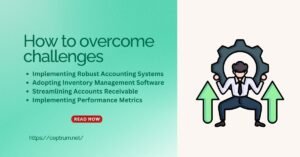Introduction
Navigating the financial intricacies of auto repair shops requires skilled accountants who can adeptly tackle a myriad of challenges. In this comprehensive guide, we’ll explore the common accounting challenges faced by these establishments and provide effective strategies to overcome them. From complex cost structures to data security concerns, let’s delve into the key hurdles that accountants for auto repair shops often encounter.
Challenges Faced by Accountants for Auto Repair Shops
- Complex Cost Structures:
Auto repair shops grapple with intricate cost structures involving inventory, labor, and overhead expenses. Tracking these costs accurately is challenging, leading to potential financial discrepancies.
- Inconsistent Revenue Streams:
Seasonal fluctuations and varying customer demands can result in inconsistent revenue, making it difficult for accountants to create accurate financial forecasts.
- Inventory Management Woes:
Managing diverse inventories of auto parts and supplies is a headache, with overstocking or understocking potentially causing financial strain.
- Compliance with Industry Regulations:
Auto repair shops must adhere to various regulations and compliance standards, adding complexity to financial reporting and tax obligations.
- Managing Accounts Receivable:
Delayed payments and outstanding invoices can impact cash flow, hindering day-to-day operations and creating financial strain.
- Technology Integration Challenges:
Reluctance to embrace modern accounting technology results in inefficiencies and increased likelihood of errors, hindering overall financial processes.
- Cash Flow Volatility:
The cyclical nature of the industry contributes to cash flow volatility, with fluctuations in customer demand and unexpected expenses disrupting financial stability.
- Employee Productivity and Efficiency:
Ensuring the productivity and efficiency of the workforce is a multifaceted challenge, impacting labor costs and overall profitability.
- Client Management and Retention:
Challenges in managing and retaining clients affect the predictability of revenue streams, necessitating improved customer relationship management.
- Training and Skill Development:
Accountants need continuous training to stay abreast of evolving accounting standards, technology, and industry best practices.
- Data Security Concerns:
With the increasing reliance on digital platforms and cloud-based accounting systems, ensuring data security becomes paramount.

Overcoming Accounting Challenges: Strategies for Success
- Implementing Robust Accounting Systems:
Tailor accounting systems to the automotive industry, enabling accurate tracking of complex cost structures and providing a clearer financial picture. Some accounting systems like: Quickbooks, freshbooks, xero, zoho books, netsuite, sage.
- Utilizing Budgeting and Forecasting Tools:
Employ budgeting and forecasting tools to navigate inconsistent revenue streams, allowing for better financial planning and resource allocation.
- Adopting Inventory Management Software:
Implement inventory management software to automate tracking, prevent overstocking or understocking, and ensure optimal inventory levels.
- Staying Informed and Compliant:
Utilize accounting software designed for the automotive sector to simplify compliance tasks and stay abreast of changes in regulations.
- Streamlining Accounts Receivable:
Implement efficient invoicing systems and utilize accounting software with robust accounts receivable modules to streamline payment tracking and collections.
- Embracing Technology:
Transition to cloud-based accounting solutions to enhance accuracy, streamline processes, and facilitate real-time collaboration between stakeholders.
- Developing Robust Cash Flow Forecasts:
Create comprehensive cash flow forecasts to identify potential gaps in cash availability and enable better financial planning.
- Implementing Performance Metrics:
Utilize time tracking systems and performance metrics to assess labor efficiency, enabling better resource allocation and cost management.
- Integrating CRM Systems:
Collaborate accounting data with customer relationship management systems to gain insights into customer behavior and foster client loyalty.
- Investing in Continuous Training:
Invest in professional development programs and online resources to empower accountants with evolving skills and knowledge.
- Prioritizing Cybersecurity Measures:
Implement robust cybersecurity measures, including encryption, secure access controls, and regular data backups, to safeguard sensitive financial information.
Conclusion
In the dynamic world of auto repair shop accounting, challenges are aplenty, but with proactive strategies, accountants can turn hurdles into stepping stones for success. By implementing robust accounting systems, embracing technology, and fostering continuous improvement, accountants for auto repair shops can navigate the complexities of the industry and contribute to sustained growth and profitability.
Read More:
how to do bookkeeping for retail store QuickBooks






